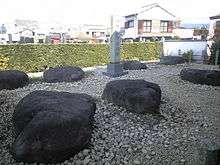Izu Kokubun-ji
| Izu Kokubun-ji 伊豆国分寺 | |
|---|---|
 Foundation Stones from the Nara period pagoda | |
| Basic information | |
| Location | Izumi-chō 12-31, Mishima-shi, Shizuoka 411-0037 |
| Affiliation | Nichiren sect |
| Deity | Shaka Nyorai |
| Country |
|
| Architectural description | |
| Founder | Emperor Shomu |
| Completed | 741 |
Izu Kokubun-ji (伊豆国分寺) is a small Buddhist temple in Mishima, Shizuoka Prefecture, Japan. It contains the foundation stones for one of the original provincial temples established in each of the provinces of Japan by the Emperor Shōmu during the Nara period (710 – 794).[1] Due to this connection, the temple grounds and main hall have been designated as a National Historic Site by the Japanese government.
History
Izu Kokubun-ji was founded in 741 as the provincial temple of Izu Province. It was converted at some uncertain time to the Shingon sect, and was burned down repeatedly in the incessant battles between the forces the Takeda clan and the Odawara Hōjō clan during the Sengoku period. In the early Edo period, it converted to the Nichiren sect and was completely rebuilt; however, these buildings were all destroyed by the 1855 Ansei Edo earthquake and the site was abandoned.
In 1923, the temple was rebuilt again as Shoren-ji (称蓮寺), and was renamed to Izu Kokubun-ji in 1954. Archaeological investigations were conducted in 1956. The foundations of the South Gate, Central Gate, Kondō and Lecture Hall were discovered, as wells as the foundations of the surrounding cloister. Outside of the main complex, eight foundation stones of the original Nara-period Kokubun-ji’s pagoda were uncovered, immediately behind the present temple’s Hondō. The site was proclaimed a National Historic Site on May 15, 1956.
References
- ↑ "Kokubunji". Encyclopedia of Japan. Tokyo: Shogakukan. 2012. Retrieved 2012-05-04.
External links
Coordinates: 35°7′12.28″N 138°54′35.1″E / 35.1200778°N 138.909750°E